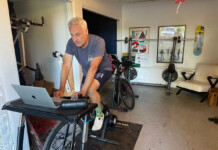By Sarah Kaufmann — One aspect of training that is completely unique to women is managing training around a menstrual cycle. The hormonal symptoms you experience; lethargy, weakness, poor balance, lack of motivation, dehydration, etc., are not in your head. There are real changes in body chemistry occurring that are causing these issues. Fortunately, understanding what is causing them and tracking your personal variations can be useful in mitigating the symptoms. There are also some simple steps you can take to help.
Women’s cycles are different so you will need to do some self-tracking to understand how your own cycle plays out and how to best manage it. Most women are on a 28 day cycle that is broken into two 14 day halves in terms of hormone balance and how you will feel. The first half, the follicular phase begins on the first day of your period. Starting after the first couple days of your period, estrogen begins to rise. This is when you can expect to feel your best. You are set up well to handle large volume and intense training. Your balance and equilibrium should be spot on, so technical skills training for off-road cyclists can be done with the best precision.
Ovulation occurs on approximately day 14, at which point estrogen drops (before rising again) and progesterone rises. This is the beginning of the luteal phase. You may retain water and experience an increased appetite and and/or cravings. The retention of water and constriction of your blood vessels increases blood pressure, resulting in a decrease in blood plasma. Progesterone also elevates core temperature approximately one degree. Up to 75% of your body’s energy can be diverted to thermoregulation during exercise so this increase in core temperature can be consequential and cause a marked decline in athletic performance.
Later in the luteal phase, progesterone also drops and initiates your period. This is a big ask of your body and energy resources that you may want to devote to training are otherwise disposed. As a result, you may feel tired, lethargic and unmotivated. When you do get on the bike, you may find that it is difficult to hit power numbers and other athletic markers can suffer, including balance and coordination. The fatigue will peak during the week before you get your period so it is a good time to schedule a light rest week.
All of this being the case, here are some helpful tips to mitigate some of these symptoms:
- To combat the bloating and water retention, make sure you stay hydrated. Water alone will not be sufficient to maintain balanced osmotic concentration. Use a dedicated prehydration product or add sea salt to your water. Salting your food can be helpful as well.
- The cramping experienced by many women is the result of prostaglandins which cause the uterus to contract prior to shedding its lining. Try taking baby aspirin (80mg dose). Note that other pain relievers and NSAIDS do not combat prostaglandins in the same way as aspirin so will not be as effective.
- Many women use hormonal contraceptives to manage their menstrual cycles and symptoms. This is a personal decision but can be consequential and have its own side effects, which is a topic for another discussion.
A great resource for further explanation on this subject is the book ROAR by Stacy Sims, PhD. Additional questions can also be directed to the author, contact info below.
Sarah Kaufmann is an elite XC and CX racer and the owner of K Cycling Coaching. She is based in Salt Lake City, UT and can be reached at sarah@kcyclingcoaching.com or 413.522.3180.








